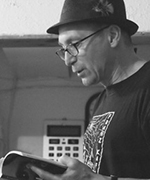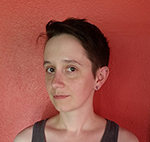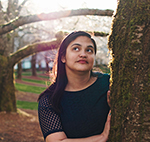Only Four Weeks Left: Enter to Win $1000 & Book Prize!

Writers from around the world are invited to enter their personal essays, memoirs, narrative nonfiction pieces, social commentaries, travel writing essays, historical accounts, biographies, etc. One winner will take home the $1,000 grand prize!
Entry fee comes with a complimentary one-year print subscription:
$35 CAD for Canadian entries
$40 USD for entries from the USA
$45 USD for entries from elsewhere
We're also offering a superb book prize raffle of four nonfiction works to one lucky contest entrant! All you have to do is submit to the contest; after the deadline, we'll pull one name from the list of entrants.
The judge for 2019 is Yasuko Thanh. Read an interview with her below!
Full contest information on The Malahat Review website.
Interview with CNF Contest Judge, Yasuko Thanh
 Malahat Review volunteer Rose Morris talks with Constance Rooke Creative Nonfiction Prize judge Yasuko Thanh about research vs. travel, music vs. writing, and what it means to judge the Constance Rooke CNF prize.
Malahat Review volunteer Rose Morris talks with Constance Rooke Creative Nonfiction Prize judge Yasuko Thanh about research vs. travel, music vs. writing, and what it means to judge the Constance Rooke CNF prize.
RM: What are you looking for in a winning submission for the Constance Rooke Creative Nonfiction prize?
YT: What am I looking for? A story with a heartbeat, the ring of truth; to be surprised on every page with turn of phrase, or metaphor, or image so apt it’s breathtaking. Insight. A climactic “punchline” in the sense that its timing is perfectly paced and creates a resolution as inevitable as unexpected.
Read the rest of Yasuko's interview on our website.
Spring Issue Interview with Armand Garnet Ruffo on Poetry
 Malahat Review volunteer David Griffin Brown talks with Armand Garnet Ruffo about conformity, traditional knowledge, and treaties in his poems, "Pink Mints" and "Filament."
Malahat Review volunteer David Griffin Brown talks with Armand Garnet Ruffo about conformity, traditional knowledge, and treaties in his poems, "Pink Mints" and "Filament."
DGB: I love the spare storytelling style of “Pink Mints,” as well as the bittersweet contradiction between the adoration and disavowal of Mervin. How did you decide to write this poem in prose instead of verse? At what stage in crafting a new poem do you know what form it should take?
AGR: The main theme in the collection Treaty # is the concept of treaties; these include official governmental treaties, the kind Indigenous peoples signed with the Government of Canada, but also those kinds of treaties we make with ourselves. By this, I mean the various ways we come to terms with all those influences, which makes us who we are, and, accordingly, how we present ourselves to others, etc. “Pink Mints” then captures a moment in time where the poet is looking back at an incident in his life and coming to terms with it. On the face of it, the poem is talking about societal pressure to conform. To some extent, we’ve all experienced this pressure, which is especially pronounced when we are young. And, of course, implied in the poem is the Indigenous theme of acceptance of the “other” which does not exist outside the community. As for form, my poems tend to arrive as a package from the outset with content demanding a specific form. Rarely do I go back and change the form of a piece to any great extent. If I do, the poem tends to fall apart. Such fragile things.
Read the rest of Armand's interview on our website.
Summer Issue Interview with Sasha Penn and Joanne Rixon on Fiction
Malahat Review volunteer Paige Lindsay talks with Sasha Penn (left) and Joanne Rixon (right) about the importance of place, their collaborative process, and the research they put into their story, "Cascades."


PL: The fantastical elements in this piece are wonderfully wrought and skillfully woven into the moments of conflict throughout "Cascades." It made me think of creation myths and legends, and the power and significance of storytelling. Was there a particular myth that you had in mind while writing this story? What else inspired you to write "Cascades"?
JR: For me, I was inspired more by real life than by myth. I’ve done a certain amount of work as an activist and one thing that has always been so frustrating to me is the trouble I have imagining what a better world would actually be like. If you can’t even imagine where you’re going, how can you get there? There is so much historical reality in this story that the ending was impossible for me to imagine for a long time.
Maybe that’s a kind of inspiration: I knew that imagining a solution for injustice is something that feels beyond my power and so I wanted to see if it was possible.
Also, shout out to Terry Bisson’s novella FIRE ON THE MOUNTAIN, which you should absolutely read if you can get your hands on a copy, because General Harriet Tubman as the leader of a black socialist democracy built on the smoking ruins of the old American South is …just, perfection.
SP: There isn’t a particular myth behind this story. I grew up listening to my mom and other storytellers. We would sit quietly and learn about how we were born, about shapeshifting, our animal relatives, and how things came to be, like our ability to use fire. This story is a mix of elements and influenced from traditional Native American storytelling. Unfortunately, I don’t have any information to credit someone. These stories exist throughout the ages and take on the voice of whoever is telling them.
Read the rest of Sasha and Joanne's interview on our website.